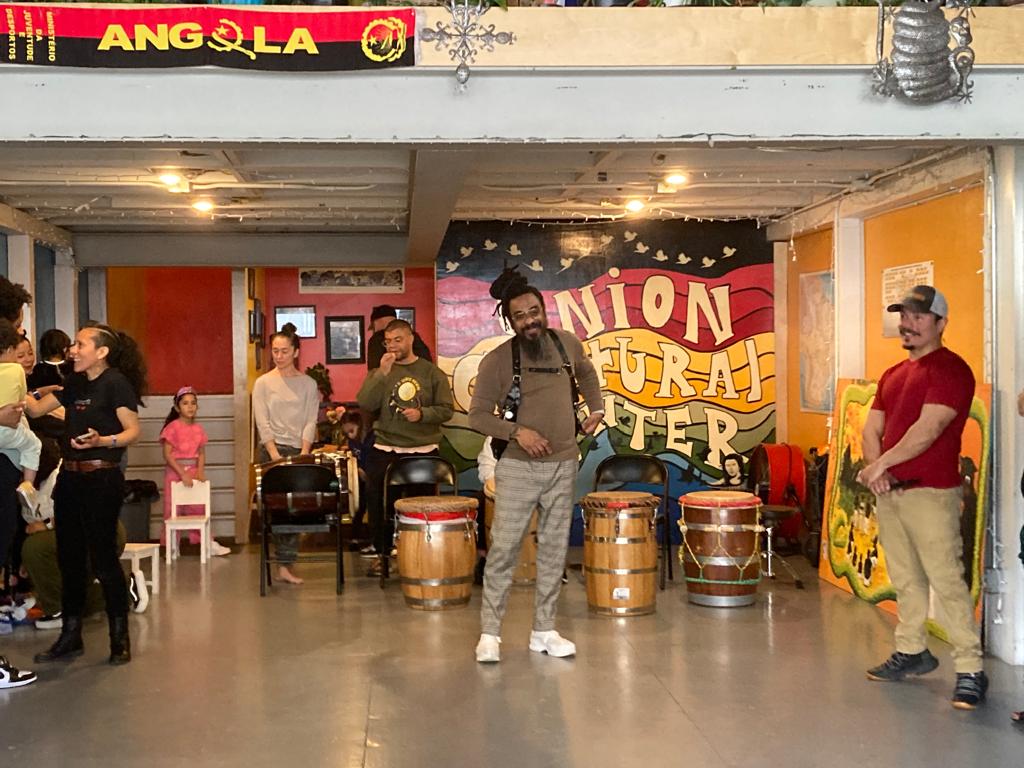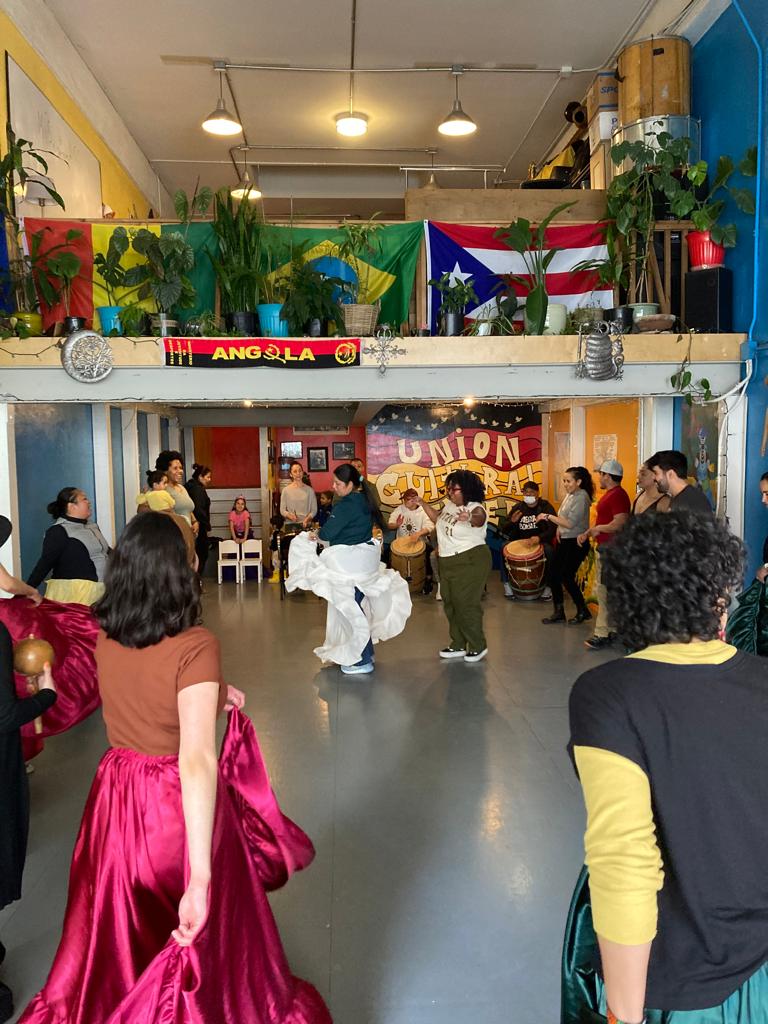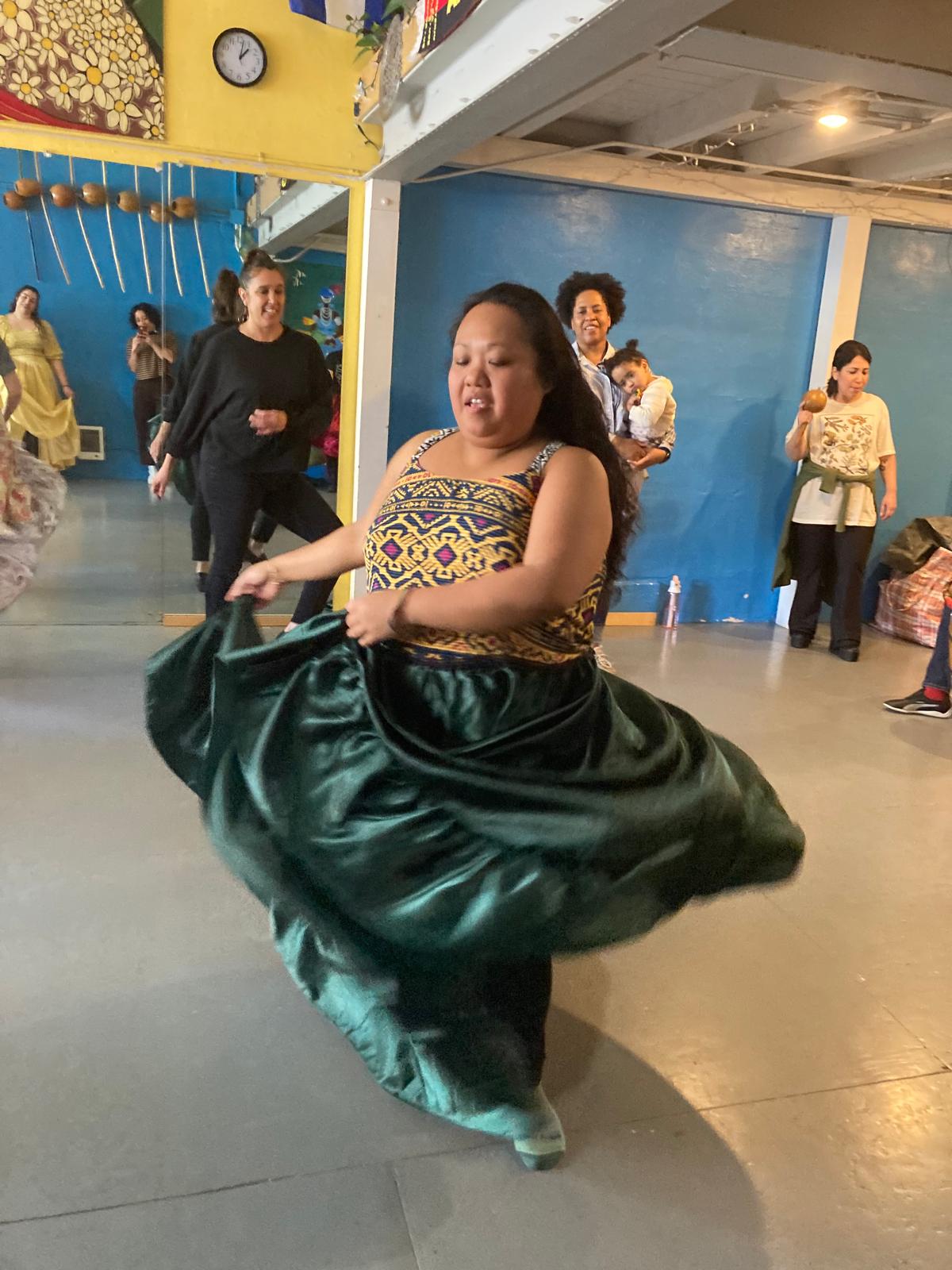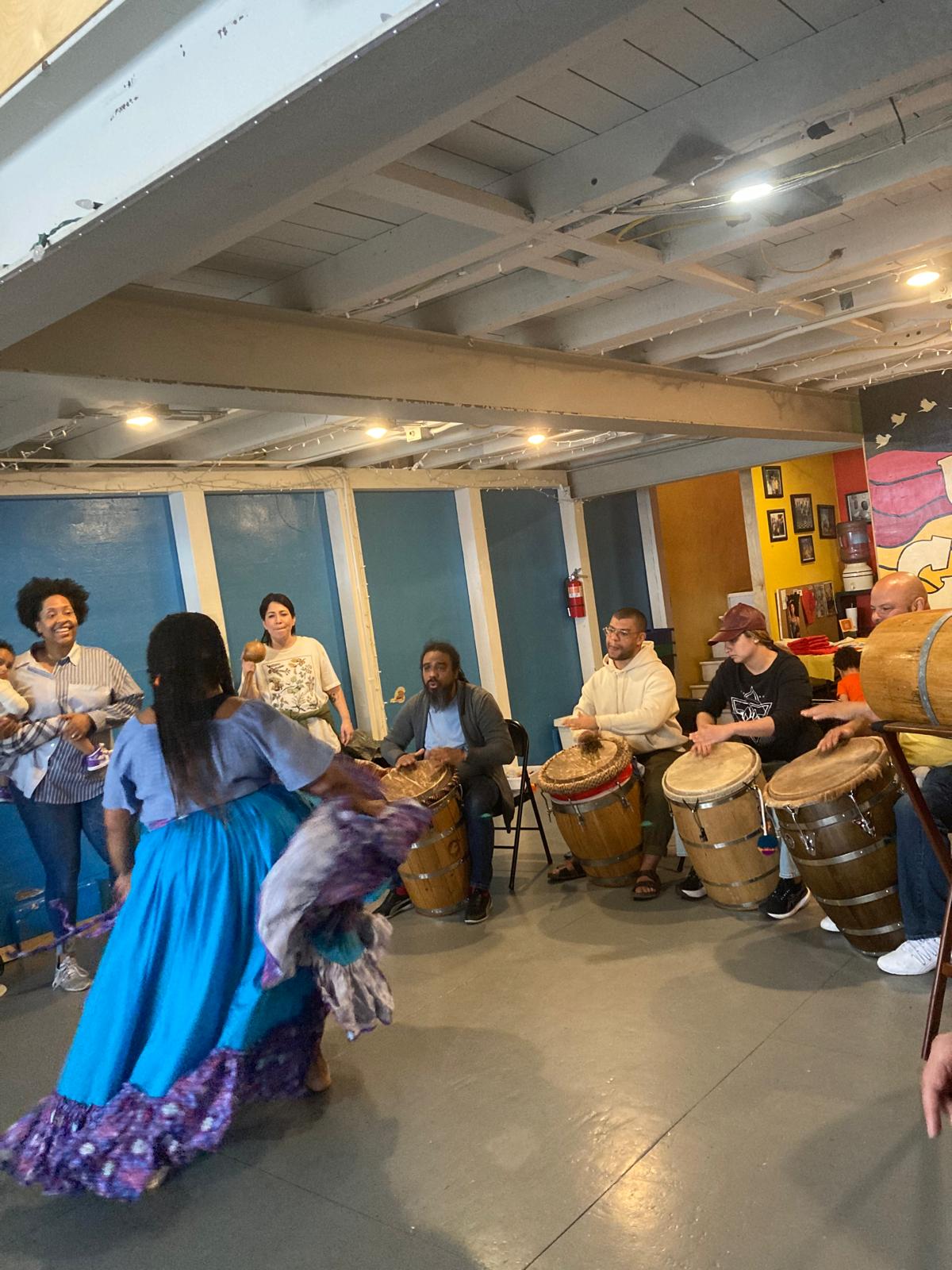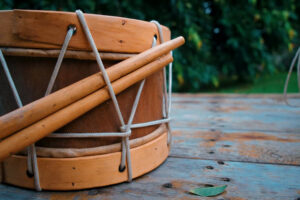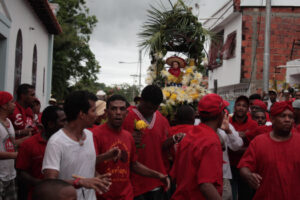“When our hands connect with a DRUM that vibrates with our energy, vitality, emotion, euphoria, hope, sensitivity, surrender, sharing and unity, we become whole again.”
Barry Bittman, MD
Otoqui Reyes, a Black Puerto Rican man born in Rio Piedras and raised between Carolina and Loíza, comes from a family of musicians and traditional bomba dancers. “I’ve been listening to bomba barrels since I was in my mom’s belly, the first drum I heard was her heart, and she, pregnant with me, was still dancing bomba.”
Tell us about Loiza, that place that inspires you and connects you with Bomba:
Loíza is Maroon land which means it was inhabited by descendants of Maroons who escaped from slavery or bought their freedom, it was a place that was divided by the Grande River of Loíza, which later flowed into the sea. Native Taíno and African land. Bomba has that same influence. Therefore, it is totally different from other bombas in other regions.
Tell us more about how you got involved in bomba:
My father created his group Agüeybaná where he had the blessing, permission, and help of the Cepeda family through one of the sons of Jesús Cepeda who is one of the main dancers of the family, Rubí and Orlando Perucho Cepeda. When I attended rehearsals with my father, I started to listen to the music and it awoke in me the interest to dance. My father taught me, and at that time I was like the mascot of the group. I went out with them, I danced, I would repeat what I saw, but it was a kind of game. Some time later the group broke up, everyone started to do their own thing, and after being in bomba for so many years, I started to move to other genres such as hip hop, breakdance and all the modern stuff. Once again, my father called me back to traditional music to learn the history of what bomba is all about. Bomba was created by Puerto Ricans and the three races: African, Native Taino, and Spanish. We have those same three roots in bomba, as we have it as a Puerto Rican, as an identity, and that’s where I went, coming back to bomba, getting to know other bomba rhythms, like the one from the southern region of Puerto Rico, which is Guayama, Ponce, Arroyo, Patilla.
Now you are a teacher, the bearer of an ancestral legacy, part of a dynasty that will possibly continue with your son. At what point did you feel that bomba has a transformative power on people and on you?
In a workshop I gave years ago for the deaf and deaf-mute, I had my doubts whether the workshop would work. And how is this going to work? And I said: come on, let’s do it; I gave the workshop with my father, I started with the basic steps. They did the basic steps on time, everything perfect. And I asked them if they had any doubts, but the one who had doubts was me. How can they follow the sound of the drum? She asked the young people this question and the young people bent down and touched the floor, pointing to the floor. That’s something they feel. The vibrations. They transmit it according to the rhythm, they understand how to move. And that’s when I said Oh! This isn’t something that you just hear, it’s something that you feel. In the course of my movement and growth in bomba, I’m still growing and learning, I said something that you feel in addition to you listening it’s something that you feel and that’s something that as I’m telling it, it’s something that moved me and I said wow!, then I started to see bomba in another light, which is, to feel it. The barrel is a drum, each drum we have on the island has a different vibration, and each rhythm has that magic that makes you move your body in a different way. Each rhythm has its flavor, has its way, and as a result the body responds.
Bomba is an element of resistance, as well as a community setting that links everyone. Something beautiful that happens in bomba is the rueda (wheel). Tell us more about this moment.
The rueda is something that is used for everything, built by people gathered around to form a circle and in the center something important happens, this is a common practice that we have as afros and as natives. The inside of the rueda is known as the batey, which is a native Taíno word that we have, which means the area where it happens. So that is where the instruments of the bomba are located. And it’s where the person who is going to dance enters. So you can dance in a couple or alone. There are different dynamics in the Santurce or Cangrejo area. The couple comes out, the gentleman leads the couple on a walk. He goes around once. And he gives her the stage so she can enter. He continues doing the basic step, doing figureo while the lady or the couple finishes dancing and once they embrace, he returns once more, leads them around the circle, greets her and they go out.
Bomba is a danceable Afro-Puerto Rican meta-genre that emerges, through time, from various and diverse African and Afro-descendant dance forms throughout our archipelago. It was practiced both in the streets and squares of urban centers and in the “soberaos” of the haciendas and plantations with large contingents of enslaved human beings. The dance genres that make up this meta-genre are known today by their proper names: candungué, sicá, paulé, holándes, yubá, güembé, leró, gracimá, holandé, calindá, yubá, belén, cunyá, seis corrido and mariandá.
What are these rhythms that make up bomba and do each of these rhythms have a particular connotation to communicate, to communicate something in particular?
When I learned Cuembé, it’s a cadenced rhythm, it’s like a flirtatious rhythm, which were normally songs, songs like: Adios mis ojitos, adios mis ojitos, adios mis ojitos, adios mis ojitos, la hacienda ha molido otra vez, adios mis ojitos, adios (Goodbye my little eyes…the hacienda has milled again). It’s like a lament, but at the same time it’s like, I’m saying goodbye, but I’m also talking about how lovely the whole thing was. I mean, it’s kind of cadenced. It’s one of my favorite rhythms.
There’s Sicá, a line rhythm like tinta y tinta, it’s normally used to start the bombazos, to start bomba with a simple rhythm, but it also has its own character. It’s like if you want to learn bomba, let’s start with that. This time the Yubá is like the one I was talking about. It’s a lamenting rhythm, a sad rhythm or a pretty serious rhythm. Normally in bomba the Yubá is totally different from all the other rhythms, because it’s in six by eight, it’s an Afro metric style, only super, super, super adult people are allowed to play it. No one under their age could dance bomba. They determined who could dance bomba and you had to be the most pro or they had to have granted you that level, so that you could dance it, but normally only to very adult people
It is a serious rhythm, a rhythm with a lot of lament, a lot of charged sadness. There is also the holandés, a rhythm with a lot of energy, with a lot of joy. Normally it’s used to close the party, to close the bomba dance or bombazo. It’s where you can normally dance a lot, you can dance normal or normally it’s done as a rueda. Where I go, where I dance, it’s done a little bit all I want, I move, the other person comes and that’s how bomba is normally danced by one person in front of the drum, just a couple. One person comes out in a couple, the first person dances and the second person dances and leaves. Then. But if you make a rueda on that rueda, one person goes out, dances and the rueda goes on, the other person comes in and goes out. But normally holandés is a rhythm with a lot of energy, a lot of joy.
From your point of view, can you tell us what are the specific contributions that the African culture of African ancestry has made to bomba, both, let’s say, in the traditional and in the current one.
Well, look, starting with the fact that thanks to them we have our bomba barrels. The landowners or the Spaniards did not allow them to play or create their own drums, for fear of witchcraft and other fears. So they had to resort to the elements that they had access to such as the barrels where they loaded, meats and other foods to store in the ships. When they discarded them, they would throw them away and the Africans would take them and put goat skin and wedges, pieces of wood around them, and with lime, with fire they would tune the drum. In those times there was also rum, that is to say, those were also used. Obviously many of the songs have African or Creole language, Creole in Mayagüez, one of the regions of Puerto Rico.
Bomba was created by the Africans and the Taínos with the influence of the Spaniards, because they also influenced how they were dancing. Bomba was used as a form of communication. They took [people] from different parts of West Africa so they could not communicate with each other, but they managed to communicate through music as a way of communicating, a language, through bomba.
They managed to communicate through sound and movement. As they danced, they made movements and gestures where they let it be known; Today we are going to escape a la a la a la a la. At the tenth hour. At 10:00 p.m. Huh? I heard that tomorrow, uh, they are taking the son of Malta. All this, through gestures and movements. They managed to communicate, to start a rebellion, to do everything. In other words, bomba was also a means of communication.
We understand that, especially in Afro traditional music, there is a very defined role for women, a very defined role for men, and this has been evolving because now we see more women on drums and as leading voices. In this sense, is bomba a safe space for diversity?
Ok, well, look, if it’s in Puerto Rico even more so. In Puerto Rico many LGBT people have been seen in bomba, they said that it’s a safe space. I dare say that yes, things have changed. Why? Because the environment of bomba was a very machista one, where women could not get close to the drum, they were only there to dance. Nor could the dancers or the dancer sit on a drum. Because you are a dancer. You are not a player. What are you doing on a drum? There was a very pronounced hierarchy. Those who dance, dance, those who play, play, those who do chorus, do chorus. Everyone had their own position and no one could jump from one place to another. And in the past, the one who played, died playing. The one who danced, died dancing, the one who sang, died singing. In other words, there wasn’t that thing that you had. You knew everything. There were personalities who knew how to do everything, but it wasn’t something very peculiar. Today in Puerto Rico you can see a man with a skirt dancing. A girl playing drums. A girl playing subidor. In my group and in Puerto Rico. I had a girl who did a very good job playing the subidor. That I trained with me.
What concerns you at the moment about bomba and what keeps you busy with bomba?
People say hey you, you play, you sing well and one says ah, thank you, but it’s the people who say it. Now, you can’t give a student a bomba class and give them a certificate and tell them “you are already a bomba dancer!”, because they will believe it, because you as a teacher told them so, but they have to keep practicing for years, that is something that they themselves will understand and put together and connect things. And the other thing that worries me is that each region has a, has a grace, has something beautiful, something peculiar. Each region Santurce. Loíza. Guayama, the Blue area, the Mayagüez area. Each region has something peculiar about each one of them. The lovely thing about Mayagüez. It’s the way they sing bombas the way they do it. It’s the beauty of Santurce. That air that the Cepeda family gave it. Loíza has its rhythm and its peculiar movements. The same with Guayama, Arroyo, but now bomba has become a single thing, where I take the steps from Mayagüez, Santurce, Loíza, Guayama and mix them and make one single thing. So within the same dance, you see all the regions. It may sound nice, but it’s not like that. You see, that’s one of the things that every person my age or older worries about and it’s sad to see a person dancing all the regions in one, in one dance.
Why is it important to continue teaching bomba in Seattle and how has it impacted your work with MÁS?
For me it’s important to do bomba because I have been able to connect with Puerto Ricans, people who are here, who have been here for seven, five years and have wanted to have the connection with their culture or who were never able to have that rapprochement in Puerto Rico for this or that reason. And here they’ve been able to find bomba and the possibility of being able to learn. I like to meet people who have a different way of learning, because that way I can guide them to where they need to go with total comfort and willingness, learning from that motivates people. In this way, step by step, I accompany them in the process and it also becomes an exchange of knowledge. Doing bomba here is good for me. After all, I love Seattle and doing bomba out here, in the street, in the sun, in the parks, and at the same time I keep working on my own culture outside the island. I keep practicing, teaching people who want to learn.
I love teaching because I carry my flag on high, my culture on high, my traditions, who I am and continue being. And at the same time I see my son who is following the same story from the belly of Naomi, his mother, my wife. Milvia has watched him grow from a very young age, already climbing on the stage, doing what he wants, what he feels. I don’t force him to play, I don’t force him to dance. I simply let him be because that’s the way I was. They let me be in bomba until I understood that it is something I have to do and I continue to do it to this day. Now another baby is coming, when it is born, so the second one is going to follow the same story. That was the bombazo, on Saturday with that baby who enjoyed that super bomba in her belly all the same. In other words, I continue working and she also feels it is important. And we continue the same tradition of inclusion, that it be something that is within our being, from the belly.
The current dance forms of bomba dances are based on the dance traditions of Loíza, Santurce, San Juan (Barrio la Perla), and Cataño, which in turn were nourished by those of Mayagüez, Ponce, Guayama and Isabela. This process of cross-fertilization was due to the large internal migration of the Afro-descendant population from all over the island to San Juan in the late 1940s and through the 1950s (Zelinky, 1949). During those two decades the government created laws that codified a cultural public policy that had a formative impact on the performance of dances with bomba (Zelinky, 1949).
1 sobera’o (circle or dance area)
2 subidor – name of high-pitched drum
Source: https://sites.google.com/ncf.edu/music-puerto-rico/g%C3%A9neros-musicales/bomba





